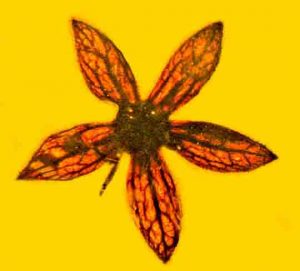
A Triceratops or Tyrannosaurus rex bulling its way through a pine forest likely dislodged flowers that 100 million years later have been identified in their fossilized form as a new species of tree.
George Poinar Jr., professor emeritus in Oregon State University’s College of Science, said it’s the first time seven complete flowers of this age have been reported in a single study. The flowers range from 3.4 to 5 millimeters in diameter, necessitating study under a microscope.
Poinar and collaborator Kenton Chambers, professor emeritus in OSU’s College of Agricultural Sciences, named the discovery Tropidogyne pentaptera based on the flowers’ five firm, spreading sepals; the Greek word for five is “penta,” and “pteron” means wing.
“The amber preserved the floral parts so well that they look like they were just picked from the garden,” Poinar said. “Dinosaurs may have knocked the branches that dropped the flowers into resin deposits on the bark of an araucaria tree, which is thought to have produced the resin that fossilized into the amber. Araucaria trees are related to kauri pines found today in New Zealand and Australia, and kauri pines produce a special resin that resists weathering.”
This study builds on earlier research also involving Burmese amber in which Poinar and Chambers described another species in the same angiosperm genus, Tropidogyne pikei; that species was named for its flower’s discoverer, Ted Pike. Findings were recently published in Paleodiversity.
“The new species has spreading, veiny sepals, a nectar disc, and a ribbed inferior ovary like T. pikei,” Poinar said. “But it’s different in that it’s bicarpellate, with two elongated and slender styles, and the ribs of its inferior ovary don’t have darkly pigmented terminal glands like T. pikei.”
Both species have been placed in the extant family Cunoniaceae, a widespread Southern Hemisphere family of 27 genera.
Poinar said T. pentaptera was probably a rainforest tree.
“In their general shape and venation pattern, the fossil flowers closely resemble those of the genus Ceratopetalum that occur in Australia and Papua-New Guinea,” he said. “One extant species is C. gummiferum, which is known as the New South Wales Christmas bush because its five sepals turn bright reddish pink close to Christmas.”
Another extant species in Australia is the coach wood tree, C. apetalum, which like the new species has no petals, only sepals. The towering coach wood tree grows to heights of greater than 120 feet, can live for centuries and produces lumber for flooring, furniture and cabinetwork.
So what explains the relationship between a mid-Cretaceous Tropidogyne from Myanmar, formerly known as Burma, and an extant Ceratopetalum from Australia, more than 4,000 miles and an ocean away to the southeast?
That’s easy, Poinar said, if you consider the geological history of the regions.
“Probably the amber site in Myanmar was part of Greater India that separated from the southern hemisphere, the supercontinent Gondwanaland, and drifted to southern Asia,” he said. “Malaysia, including Burma, was formed during the Paleozoic and Mesozoic eras by subduction of terranes that successfully separated and then moved northward by continental drift.”
Reference:
George O. Poinar, Kenton L. Chambers. Tropidogyne pentaptera, sp. nov., a new mid-Cretaceous fossil angiosperm flower in Burmese amber. Palaeodiversity, 2017; 10 (1): 135 DOI: 10.18476/pale.v10.a10
Note: The above post is reprinted from materials provided by Oregon State University.










